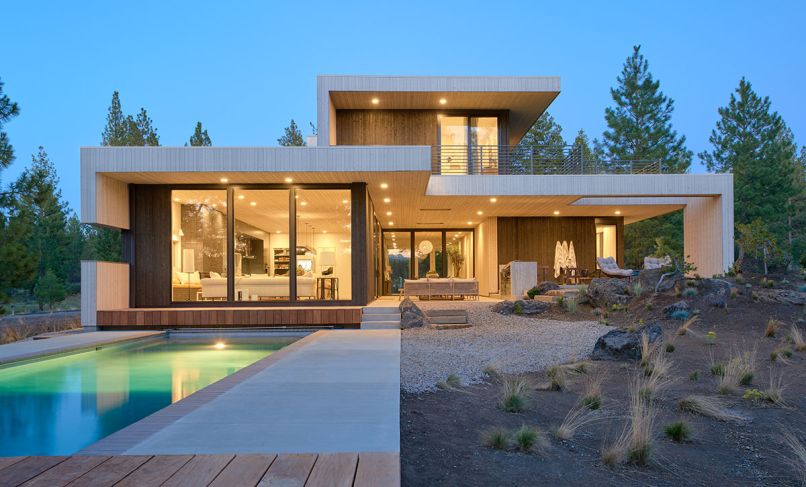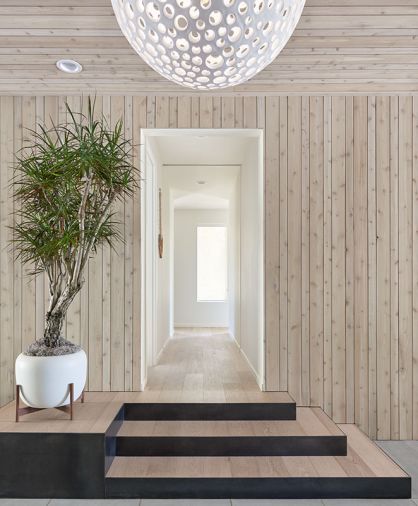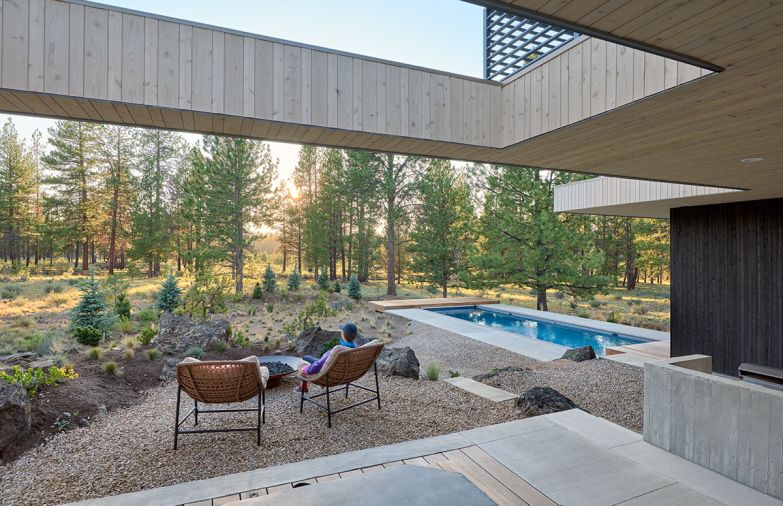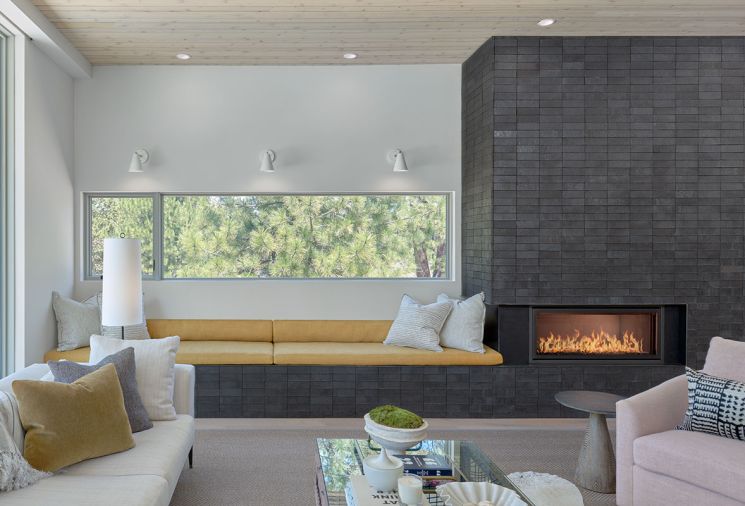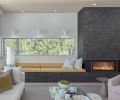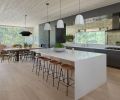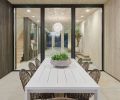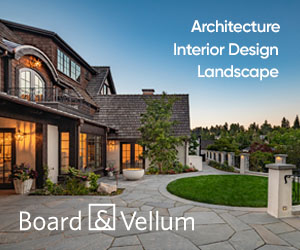When it comes to designing a house, constraints help. Whether it’s the budget, dealing with a remodel’s existing conditions, or the building site itself—perhaps flat ground here, or property setbacks there—such parameters become a designer’s guidelines at the start of a project. But for this new build on ten sprawling acres near a national forest in Bend, Oregon, those limits were few and far between. That is, until the architects found one: a “peek-a-boo” view of local mountain, Broken Top.
“It was just between some trees, at a particular angle headed west,” says architect John Brockway of Lightfoot A-D. “We basically set up a little stake and said, ‘This is the center of the home.’” Brockway collaborated with architect Eric Meglasson, as well as interior designer Lucy Roland of Harper House Design, and CS Construction. That view corridor gave the team a place to start.
Of course, the owners had a budget and a program, including needing the typical living areas and three bedrooms for their family. But other than that, they were open to ideas, not just as to where the home should be placed, but how it should look. They had recently come back from living in Spain for two years, and while there, became enamored with modern design.
“We did go through probably more design concepts than we ever have on any project,” says Meglasson. “The reason being that the homeowners knew they wanted what they described as a beautiful modern house. But it was a new idea to them to even consider living in a modern house, so they couldn’t give us much direction beyond the basic program. Every time we’d show them a design, they would say, ‘That’s really cool, but what else?’”
Meglasson and Brockway, who are friends and have worked on several houses together, enjoyed swapping ideas. “Part of it was, the clients were interested in everything that we were proposing,” says Brockway. “At the same time, Eric and I were just having fun, riffing, sending stuff back and forth and coming up with ideas. Some of those were really wild and some were a little bit more restrained.”
The resulting home, finished in 2019, is 3,400 square feet spread over two floors, with a coterie of outdoor spaces, including an entry breezeway, roof deck, and covered rear lounge connected to a pool. One idea that remained a constant during the creative play was a stacked and shifted cube approach. This consists of three darker-toned volumes arranged around a central glassed vestibule, which was where the architects placed their original “stake.” “The idea is that the stake at the center of the house would become the middle of this gallery at the entry,” says Brockway. “So that when you first walk in, you’re on axis with Broken Top.”
Each box serves a function in the plan. On the lower level, the main living spaces are in one, and the primary suite and an office in the other. Up top, find the children’s bedrooms and hang out zone. On the exterior, rough-sawn vertical black-stained cedar siding is wrapped in a lighter cedar wood for demarcation, with the wrap extending to form deep roof overhangs and protected outdoor spaces.
For the interior, Roland assembled a palette of finishes, fixtures, and furnishings that adhere to the couple’s modern preferences, but still feel welcoming and family friendly. “The way we achieved that is with really fun lighting throughout, layering a lot of neutrals, and adding texture where we can,” says Roland.
Roland picked up the architects’ juxtaposition of dark and light, bringing the light exterior siding indoors to cover the ceiling and an accent wall in the entry. Wide plank white oak floors are punctuated with charcoal gray laminate kitchen cabinets and a glazed brick fireplace. Pops of color and pattern, like a powder room’s wallpaper and the bright yellow window seat in the living room, offer moments of contrast, mood, and discovery. “I love the pop of sunshine yellow against the black brick,” says Roland. “It’s such a happy corner.”
Since construction finished, the house has proved a boon for the owners, serving as their modern family compound with a fluid connection to the landscape, thanks to that initial stake in the ground and every design decision thereafter. “Much like the clients, we felt a deep connection with the building site. It is rare to build in such an untouched natural space. During construction, we took great care to minimize our impact on the surrounding environment,” notes Matt Cohen, Managing Partner at CS Construction. “The house stands as a tribute to its natural surroundings, and we feel privileged to have played a part in bringing it to life.”
PROJECT SOURCES
ARCHITECT
Eric Meglasson Architect
meglassonarchitect.com
ARCHITECT
Lightfoot Architecture & Design
lightfootarchitecture.com
INTERIOR DESIGN
Harper House Design
harperhousedesign.com
CONTRACTOR
CS Construction
csconstruction.com
WINDOWS & DOORS
Pella Windows & Doors
pella.com
Shoptalk - Eric Meglasson

Eric Meglasson, principal, Eric Meglasson Architect meglassonarchitect.com
As a designer of modern architecture for 25 years, how has your viewpoint evolved?
My focus has shifted from simply wanting to create modern homes, to wanting to create modern homes that truly belong to the site they were designed for.
How does living and working in central Oregon impact your design?
Living in this incredible place has had a massive influence on how I view architecture; from connections the building gives its inhabitants to their surroundings, to an awareness of how the resources we consume as we build can influence the environment we live in. I love the western U.S. for its raw and natural beauty. In the process of creating architecture, I think we as designers must strive to protect and enhance the natural world.
You focus on light-filled, nature-connected homes, what speaks to you about these projects?
I love the natural beauty of the region in which we live. I think helping people be more aware of the world around them enhances the quality of their lives. It creates an awareness of the changing seasons and the qualities of light throughout the day. I believe people’s lives are enhanced when they are more connected with the cycles of nature.
You are known for collaborating with a number of architects and designers. How has this impacted your work?
I get a great deal of satisfaction from collaborating with other highly inspired and talented architects. It keeps my enthusiasm level high. Collaboration can help me see different aspects of a design approach that I may not have considered. When working together, we tend to arrive at solutions that we may not have discovered on our own. There’s an energy that is created when designers are sharing, then enhancing each other’s ideas. It makes the design process a lot of fun.
What are some key takeaways from working on projects around the world, including locations such as the Rocky Mountains, Palm Desert, Northern Europe and Eastern Africa?
The most important takeaway is the fact that humans are pretty much the same all around the world. They strive for the same things: health, joy, security, and prosperity for their families. The small differences in culture are what make the world a rich and beautiful tapestry and so much fun to explore. I think the most successful buildings in any location are the ones built with local materials and offer a strong passive response to the climate in which they exist.
What keeps you excited about residential architecture?
Every project, every client, and every job site are unique. The process of solving the challenges presented with each new home is what keeps me motivated and excited.
Describe your design philosophy.
I could spend 20 hours talking about this topic. Simply put, I believe buildings should be designed to enhance the quality of the land they occupy, while satisfying the needs and desires of their inhabitants.
Favorite place to travel?
Anywhere in the American West. I love the desert. I love to explore wild and new places.
What draws you to mountain biking?
Being in the woods and spending time with friends and family are what I love most about the sport. My dad, who was one of the first mountain bike trail builders in the area, introduced me to mountain biking when I was eleven. I have been following him around the forest for the past 40 years and am lucky that I still get to ride with him.

